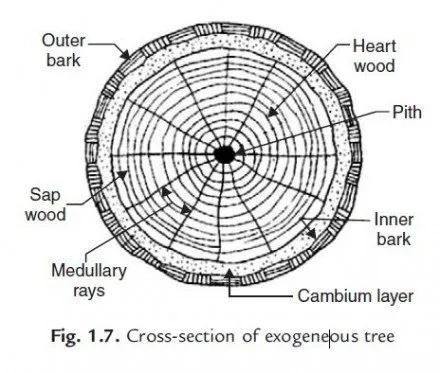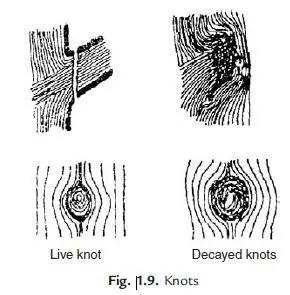This is a process by which moisture content in a freshly cut tree is reduced to a suitable level. By doing so the durability of timber is increased. The various methods of seasoning used may be classified into:
(i) Natural seasoning
(ii) Artificial seasoning.
(i) Natural Seasoning: It may be air seasoning or water seasoning. Air seasoning is carried out in a shed with a platform. On about 300 mm high platform timber balks are stacked as shown in Fig. 1.8.
Care is taken to see that there is proper air circulation around each timber balk. Over a period, in a natural process moisture content reduces. A well seasoned timber contains only 15% moisture. This is a slow but a good process of seasoning.
Water seasoning is carried out on the banks of rivers. The thicker end of the timber is kept pointing upstream side. After a period of 2 to 4 weeks the timber is taken out. During this period sap contained in the timber is washed out to a great extent. Then timber is stalked in a shed with free air circulation.
(ii) Artificial Seasoning: In this method timber is seasoned in a chamber with regulated heat,
controlled humidity and proper air circulation. Seasoning can be completed in 4 to 5 days only. The
different methods of seasoning are:
(a) Boiling
(b) Kiln seasoning
(c) Chemical seasoning
(d) Electrical seasoning.
(a) Boiling: In this method timber is immersed in water and then water is boiled for 3 to 4 hours.
Then it is dried slowly. Instead of boiling water hot steam may be circulated on timber. The process of
seasoning is fast, but costly.
(b) Kiln Seasoning: Kiln is an airtight chamber. Timber to be seasoned is placed inside it. Then
fully saturated air with a temperature 35°C to 38°C is forced in the kiln. The heat gradually reaches
inside timber. Then relative humidity is gradually reduced and temperature is increased, and maintained till desired degree of moisture content is achieved.
The kiln used may be stationary or progressive. In progressive kiln the carriages carrying timber travel from one end of kiln to other end gradually. The hot air is supplied from the discharging end so that temperature increase is gradual from charging end to discharging end. This method is used for seasoning on a larger scale.
(c) Chemical Seasoning: In this method, the timber is immersed in a solution of suitable salt.
Then the timber is dried in a kiln. The preliminary treatment by chemical seasoning ensures uniform seasoning of outer and inner parts of timber.
(d) Electrical Seasoning: In this method high frequency alternate electric current is passed through timber. Resistance to electric current is low when moisture content in timber is high. As moisture content reduces the resistance reduces. Measure of resistance can be used to stop seasoning at appropriate level.
However it is costly process. This technique has been tried in some plywood industries but not in seasoning of timber on mass scale.



LOOKING FOR INFORMATON OF TIMBER WATER SEASONING
Logs of wood are emersed in running system of water with a larger ending pointing upstream.The sap,sugar and gum are leached out and are placed by water.Thereafter, the logs are then kept out in air to dry.
good short and effective
nice.. i got it
nice
n hanks
nice n thanks…….
very brief and straight
to the point. am greatful.